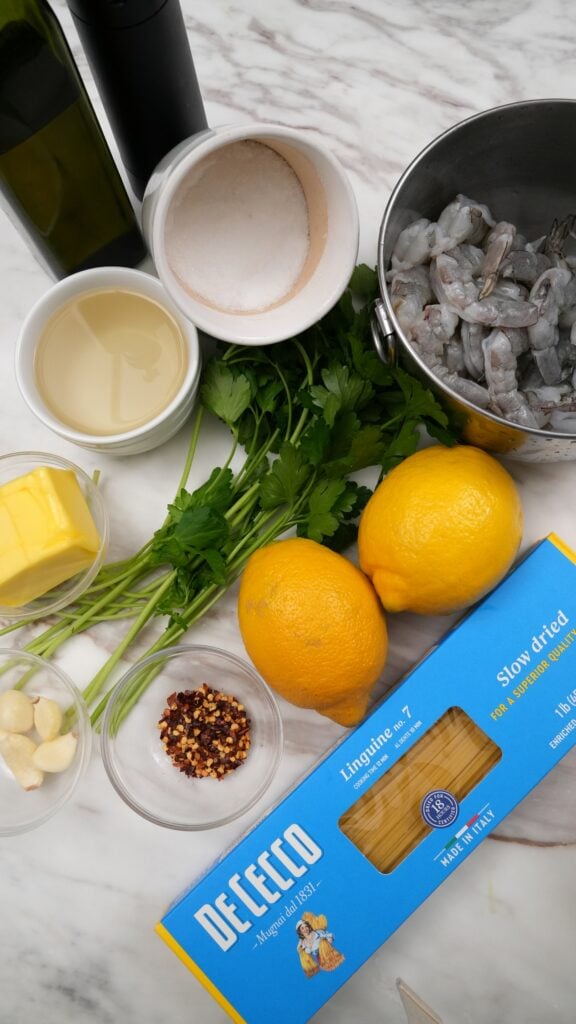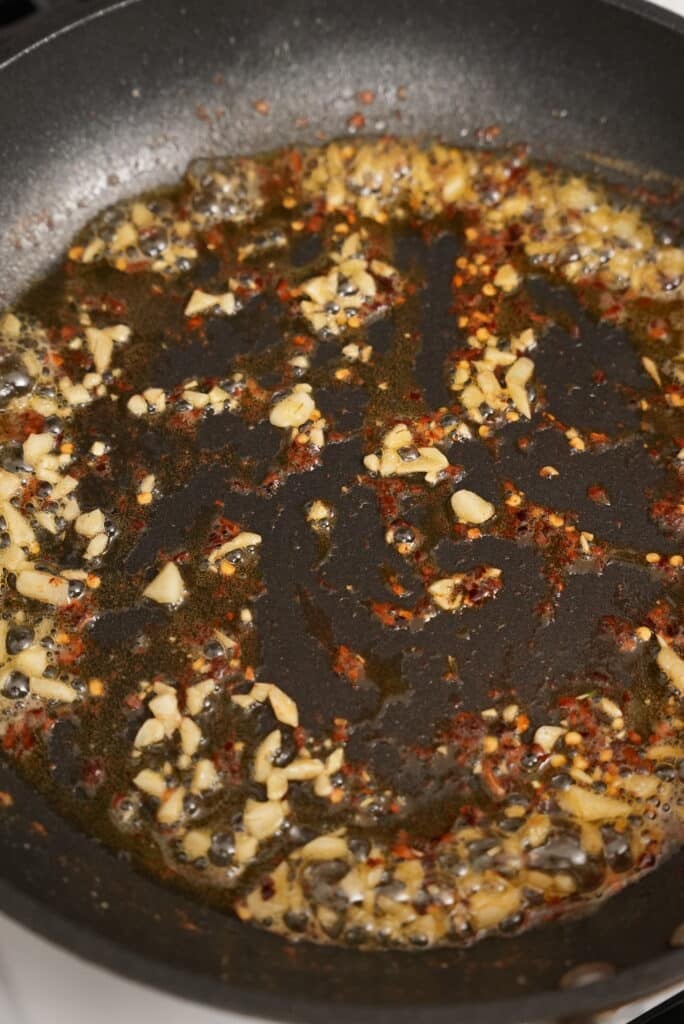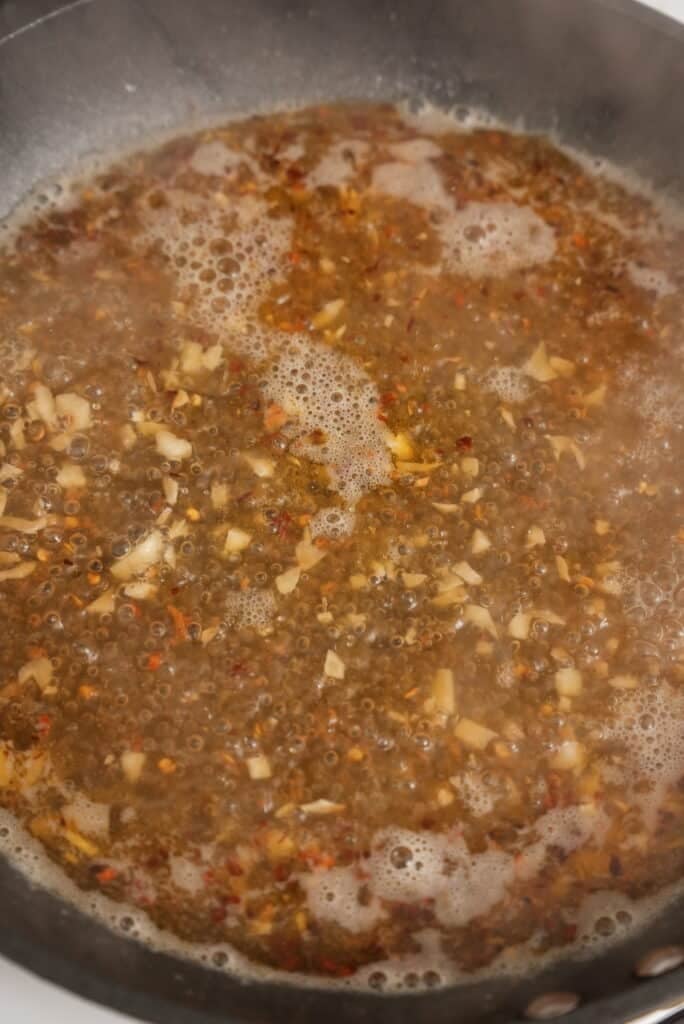One of those comforting seafood pastas that’s great for a quick and easy dinner is Shrimp Scampi Pasta. The shrimp are juicy and buttery, and the bright, lemony sauce goes great with the al dente pasta.
You can make Shrimp Scampi Pasta on a weeknight or for a special event to impress people.
Shrimp scampi fettuccine is a delicious Italian-American pasta dish made with shrimp, garlic, white wine, butter, and herbs It’s rich, flavorful, and incredibly easy to make at home In this article, we’ll cover everything you need to know about making shrimp scampi fettuccine, from choosing the right ingredients to cooking techniques and serving suggestions.
An Overview of Shrimp Scampi Fettuccine
Shrimp scampi fettuccine features tender fettuccine pasta tossed with plump, garlicky shrimp and a buttery lemon-wine sauce. It’s an indulgent dish that feels special but requires little effort to prepare. The star ingredients are the shrimp and the sauce. Large or jumbo shrimp work best as they hold up nicely when sautéed. The scampi sauce is made by cooking garlic briefly in olive oil, then adding white wine, lemon juice, butter, and herbs. It comes together quickly while the fettuccine pasta cooks. Within 30 minutes, you can have a restaurant-quality meal on your dinner table.
Some key features of shrimp scampi fettuccine:
- Garlicky, lemony flavors shine through
- Rich, creamy sauce coats each strand of pasta
- Sweet shrimp contrast with bright acidity from wine and lemon
- Quick, easy weeknight meal as well as dinner party fare
- Endless adaptability -customize flavors to your taste
While this dish is an American favorite, it actually has Italian roots. The term “scampi” refers to a type of small lobster or shrimp popular in Italian cooking. Italians often prepare seafood very simply to let the natural flavors shine through. Shrimp scampi fettuccine honors these origins while also incorporating ingredients more common in American cooking.
Step-By-Step Guide to Making Shrimp Scampi Fettuccine
Making shrimp scampi pasta at home is easy. Here’s a step-by-step overview:
Prep the ingredients
- Rinse and pat dry 1 pound of large, raw shrimp. Devein if needed.
- Mince 3-4 garlic cloves.
- Grate lemon zest and squeeze juice from 1 lemon.
- Chop fresh parsley or basil.
- Measure out white wine, olive oil, butter.
- Cook 8-12 ounces fettuccine pasta according to package directions.
Make the scampi sauce
- Heat olive oil in a skillet over medium heat.
- Add garlic and a pinch of red pepper flakes. Cook 1 minute.
- Add shrimp and cook 1-2 minutes per side until pink. Remove shrimp to plate.
- Add wine, lemon juice, and butter to pan. Cook 2-3 minutes until sauce reduces slightly.
Finish the pasta
- Toss cooked fettuccine with scampi sauce until coated.
- Return shrimp to pan and cook just until warmed through.
- Stir in herbs, lemon zest, salt, and pepper.
- Serve shrimp scampi fettuccine hot with grated Parmesan cheese.
It’s that easy! The sauce comes together while the pasta cooks so dinner is ready in under 30 minutes. Next, let’s go over how to choose your ingredients for the best flavor.
Selecting the Best Ingredients for Shrimp Scampi
Great shrimp scampi starts with high-quality ingredients. Here are some tips on choosing ingredients to make your dish taste amazing:
Shrimp
- Use raw, shell-on shrimp if possible for the best flavor.
- Opt for large or jumbo shrimp (16-20 or 21-25 per pound).
- If using frozen shrimp, thaw completely first.
Pasta
- Stick with long, thin pastas like spaghetti, linguine or fettuccine.
- Cook pasta al dente so it can absorb sauce.
- For best results, cook pasta before making the sauce.
Garlic
- Use fresh garlic cloves, minced or pressed.
- 3-5 large cloves gives great garlicky flavor.
Butter & Oil
- Splurge on high-quality butter for richest flavor.
- Good olive oil is also key – not too heavy or strong.
Wine
- Choose an affordable dry white wine you enjoy drinking.
- Sauvignon blanc or pinot grigio work well.
- Add wine gradually and cook briefly to mellow alcohol flavor.
Herbs
- Fresh parsley, basil, or oregano add brightness.
- For simplicity, stick with just one herb.
- Add at the end to preserve flavor.
Lemon
- Freshly squeezed juice brightens the scampi sauce.
- Add zest at the end for lemon essence without acidity.
With high-quality ingredients, you don’t need much to make an incredible shrimp scampi pasta
Key Cooking Tips for Shrimp Scampi Success
There are a few easy cooking techniques to master for perfect shrimp scampi every time:
-
Don’t overcook the shrimp! Cook just until pink/opaque, 1-2 minutes per side. Shrimp gets rubbery if cooked too long.
-
Cook pasta al dente. Drain it 2 minutes before package time, so it finishes cooking in the sauce.
-
Start pasta first. Get water boiling and pasta cooking before you start the sauce.
-
Cook sauce at medium heat. Too high and garlic burns quickly. Medium heat helps develop flavors.
-
Reduce wine slowly. Let it simmer gently to cook off alcohol flavor and concentrate natural sweetness.
-
Remove pan from heat before adding cheese or herbs, so they don’t overcook.
-
Serve immediately. Toss everything together right before serving, while hot.
It just takes a little practice to perfect the simple techniques needed for fantastic shrimp scampi.
How to Customize Shrimp Scampi Fettuccine to Your Taste
One of the great things about shrimp scampi is how versatile it is. Don’t be afraid to make it your own! Here are some easy ways to customize:
- Use lemon- or garlic-infused olive oil for extra flavor
- Add crushed red pepper flakes for a little heat
- Stir in spinach or sun-dried tomatoes for color and nutrition
- Top with fresh basil instead of parsley
- Mix Parmesan, Pecorino, or goat cheese into the sauce
- Serve over angel hair pasta, zucchini noodles, or with crusty bread for dipping
Swap seafood options:
- Make lobster scampi by substituting lobster tails
- Use bay scallops or a mix of shrimp and scallops
- For seafood scampi, use a medley of fish like cod, mussels, and clams
The possibilities are endless! Change up flavors and textures to find your favorite shrimp scampi fettuccine combination.
Serving Suggestions for Shrimp Scampi
Shrimp scampi is delicious on its own, but here are some ideas for rounding out the meal:
-
Green salad: Balance the richness with something fresh and light.
-
Garlic bread: The perfect accompaniment to dunk in your plate!
-
Steamed broccoli: Another bright counterpoint to the creamy pasta.
-
Carrot salad: Shredded carrots in lemon vinaigrette complement the dish.
-
Asparagus: Quickly roast or grill a few spears.
-
Pasta alternatives: Serve scampi over risotto, polenta, orzo or cauliflower rice for variety.
-
Lemon dessert: Finish the meal with something refreshing like lemon bars or sorbet.
Any simple sides that won’t compete with the fabulous flavors of the shrimp and sauce are great options. Use the pasta water to quickly sauté extra veggies for a one-pan meal.
Frequently Asked Questions
Here are answers to some common questions about making shrimp scampi at home:
Is shrimp scampi spicy?
Shrimp scampi is not traditionally spicy, though you can add crushed red pepper flakes to the sauce if you want a little kick. Start with 1/4 tsp and add more to your taste.
Can I make shrimp scampi without wine?
Yes, you can omit the wine. Replace it with low-sodium chicken or vegetable broth. The flavor will be slightly more mild.
Can I use frozen shrimp?
Frozen shrimp works fine, just thaw it first by putting the sealed bag in cold water. Thaw slowly in the fridge if you have time. Pat dry before using.
Can I use breadcrumbs or flour to thicken the sauce?
It’s best not to thicken the delicate scampi sauce too much. Allow natural reduction and starch from the pasta to provide enough thickness once tossed together.
Can I make this with shrimp shells/tails on?

Watch the Shrimp Scampi Pasta Recipe Video Below!

Starting the Shrimp Scampi Pasta Sauce
In the same pan, heat the butter and olive oil for 30 seconds while you fry minced garlic and red pepper flakes. There is a lovely fond from the shrimp in the pan, and we are going to use it a lot!
White wine (or chicken stock if you don’t want to drink) and lemon juice should be used to deglaze the pan. Make sure to scrape up any bits from the bottom of the pan. Add black pepper and some of the pasta water from the cooked pasta. Let the sauce cook down until it’s about a third of the way full.


Keep cooking the pasta for one to two minutes less than the al dente time. Then add the pasta and some of the pasta water to the sauce right away.
